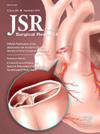Animal Models Within Surgical Simulation: A Novel Approach to the 3 Rs
IF 1.8
3区 医学
Q2 SURGERY
引用次数: 0
Abstract
Introduction
Development of technical skills is a vital component of surgical residency. The use of animal tissues for operative simulation leads to both the loss of animal life and financial costs for the institution. We hypothesized that maximizing tissue use from investigational large animal models after euthanasia could reduce loss of animal life and institutional costs by replacing commercially purchased tissues.
Methods
After animal euthanization, a resident and medical student team harvested porcine tissue commonly used for surgical simulation: abdominal wall, kidney, heart, spleen, and small intestine. Tissues were vacuum-sealed and frozen for future educational use. Outcomes of harvest yield and time and estimated commercial pricing of harvested porcine tissues were analyzed.
Results
Three timed procurements were performed with decreasing operative times (36:30, 34:00, and 30:54) and increasing harvest yields (100 cm, 160 cm, and 200 cm small bowel). Procurements were conducted within 15 min of animal euthanization. Harvested tissue was considered to be of similar quality to commercially purchased tissue. Estimated cost of procured tissues from a commercial vendor was $847 compared to $109 for direct procurement from euthanized porcine models.
Conclusions
Maximizing tissue use from large animal research models is an innovative approach to adhering to the three Rs of animal research: replace, reduce, and refine. Tissue procurement provides valuable tissues for resident education and simulation, increases surgical trainee operative exposure, and decreases institutional costs.
手术模拟中的动物模型:实现 3 Rs 的新方法。
介绍:培养技术技能是外科住院医师培训的重要组成部分。使用动物组织进行手术模拟既会导致动物生命损失,也会增加医疗机构的经济成本。我们假设,在动物安乐死后最大限度地使用研究用大型动物模型的组织,可以替代商业购买的组织,从而减少动物生命损失和机构成本:动物安乐术后,住院医师和医科学生团队采集了常用于外科模拟的猪组织:腹壁、肾脏、心脏、脾脏和小肠。组织经真空密封和冷冻后供今后教学使用。对收获量和时间的结果以及收获的猪组织的估计商业价格进行了分析:进行了三次定时采集,手术时间依次缩短(36:30、34:00 和 30:54),采集量依次增加(100 厘米、160 厘米和 200 厘米小肠)。采集在动物安乐死后 15 分钟内进行。收获的组织被认为与商业购买的组织质量相似。从商业供应商处采购组织的估计成本为 847 美元,而从安乐死的猪模型中直接采购组织的成本为 109 美元:结论:最大限度地利用大型动物研究模型的组织是坚持动物研究三R原则的一种创新方法:替换、减少和完善。组织采购为住院医师教育和模拟提供了宝贵的组织,增加了外科受训人员的手术经验,并降低了机构成本。
本文章由计算机程序翻译,如有差异,请以英文原文为准。
求助全文
约1分钟内获得全文
求助全文
来源期刊
CiteScore
3.90
自引率
4.50%
发文量
627
审稿时长
138 days
期刊介绍:
The Journal of Surgical Research: Clinical and Laboratory Investigation publishes original articles concerned with clinical and laboratory investigations relevant to surgical practice and teaching. The journal emphasizes reports of clinical investigations or fundamental research bearing directly on surgical management that will be of general interest to a broad range of surgeons and surgical researchers. The articles presented need not have been the products of surgeons or of surgical laboratories.
The Journal of Surgical Research also features review articles and special articles relating to educational, research, or social issues of interest to the academic surgical community.

 求助内容:
求助内容: 应助结果提醒方式:
应助结果提醒方式:


